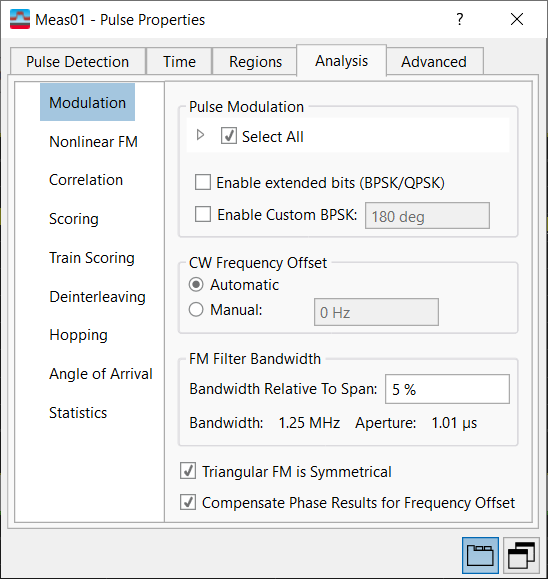Modulation (Pulse)
Menu Path:
The Analysis tab's Modulation panel lets you set modulation parameters for the current Pulse measurement.

- Pulse Modulation
Use this parameter to select desired combination of pulse modulation types you want the 89600 VSA software to automatically detect.
The Pulse Table trace displays information specific to the detected modulation type. The Modulation Type column in that table displays the detected modulation type.
- For Barker Phase, the Barker code number is automatically detected.
-
For Triangular FM Frequency Modulation, select Triangular FM is Symmetrical if you know your triangular modulation is symmetrical.
Additional information about Barker Phase and Triangular FM is available in the Pulse Modulation measurement parameters topic. - Enable extended bits (BPSK/QPSK) enables BPSK Binary phase shift keying - A type of phase modulation using 2 distinct carrier phases to signal ones and zeros./QPSK Quadrature phase shift keying long demodulation (up to 1024 bits). To view the bits, simply bring up the Pulse Demod Bits results table.
- Enable Custom BPSK allows the user to enter a custom phase shift angle for BPSK modulation.
- CW Frequency Offset
- FM Filter Bandwidth
- Bandwidth Relative to Span--Specifies the FM differentiating filter bandwidth factor, relative to measurement span. Note that the resulting FM Filter Bandwidth (Hz) and Aperture Time (sec) are also reported as additional information.
- Triangular FM is Symmetrical -- select this if you know your Triangular FM has symmetrical slopes. This constrains the Triangular FM Best-Fit reference trace to use symmetrical slope rates (Hz/us) for each of the two LFM chirps comprising Triangular FM.
- Compensate Phase Results for Frequency Offset -- When the Compensate Phase Results for Frequency Offset checkbox is enabled, the reported per pulse measured and reference synchronized phase trace results are automatically compensated for each specific pulses measured mean frequency offset from the current Center Frequency.
This parameter is used for CW waveforms and is active only when CW modulation is selected. It allows you to manually set the modulation frequency offset that will be used as the reference frequency for all pulses detected as CW modulation. If automatic is selected, then for each pulse the mean frequency is calculated and used as the reference for that pulse.
See Also
Compensate Phase Results for Frequency Offset
See "Pulse Modulation (Pulse)"
